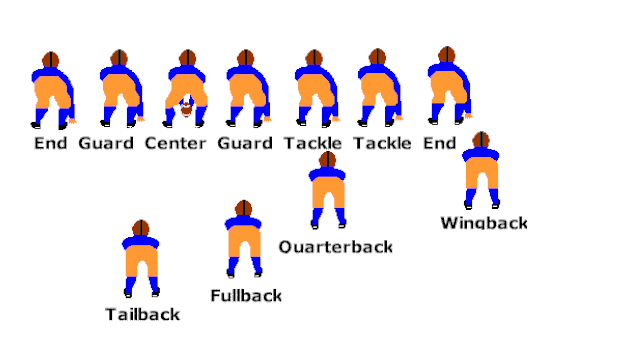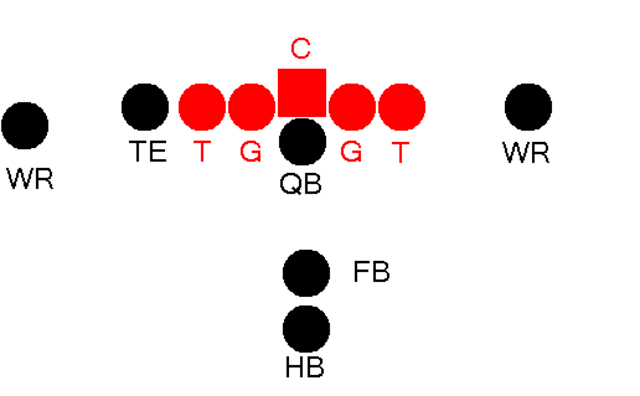Our study of gridiron history and the player positions continues with one that is less commonly used in today's college and pro football games, the fullback. We will briefly tell the origin and history of the fullback and where it is used today.
Fullback
The Fullback Position
In today’s game of American football, the fullback was almost an endangered species. Many offensive schemes as of a few years ago didn’t utilize the position much anymore. For the last 30-40 years or so the fullback has been that big athletic dude behind the QB that leads a halfback ball carrier through the line looking for a defender at the second level such as a linebacker, to go one-on-one with to spring the runner. You know the old blocking scheme of a hat on a hat. In short-yardage situations, this big brute of the backfield may plunge through the A-gap on a fullback dive play. In passing situations he stayed home to be the thrower’s personal protector in pass-pro or slip out of the backfilled altogether to grab a toss out in the flat hopefully undetected.
In the world of spread offenses, multi-tasking tight ends and five wide receiver sets the specialized blocking back wass going the way of the dinosaur. The use of eleven personnel as it is called where there is only one back and one tight end has been an extremely effective modern package for offenses to trot out on the field. It creates mismatches for defenses forcing them to leave their base defensive personnel and switch to a nickel or dime grouping. It is estimated that in 2015 less than half of the NFL employed a true fullback. In 2020 there were 22 squads using one and right now according to spotrac.com there are 25 fullbacks under contract for the 2022 season.
The mindset of a fullback is to hit someone, they are really almost an offensive lineman in the backfield. In short-yardage situations of the past in fact some teams have employed one of their big men that normally play in the trenches to act as a lead blocking back. This contact-first mentality is the polar opposite of the halfback who are the toters of the rock, as their avoidance of defenders is the natural instinct.
History of the gridiron fullback
Back in the days when the same eleven players basically stayed on the field in the single platoon system, the fullback was the guy traditionally deepest in the backfield. This term “full” came from fully back behind the line. Often times they were the team's kicker and punter too because in a scrimmage kick formation what other player on the offense is further from the line of scrimmage that the kicker? Back in this era, before the T-formation most teams had four back between the tackles made up of a QB two halfbacks, and the fullback. The quarterback began each play a quarter of the way "back" behind the offensive line, the halfbacks began each play side by side and halfway "back" behind the offensive line, and the fullback began each play the farthest "back" behind the offensive line. The T-formation reset the fullback between the two halfbacks so that they were all in a line equal-distant from the linemen, while the quarterback was under center. He wasn’t the “fullest“ player behind the offense anymore in this scheme but the traditional name for the position was kept to identify.
Illustration is Courtesy of Wikimedia Commons of an unbalanced Single-wing football formation created by Bill Spencer. The single-wing formation was one of the more common offenses in the early twentieth-century.
With the advent of the T-formation and other offensive schematics, one of these two halfbacks started to move into the slot positions outside of the tackles. The fullback then was repositioned closer to the line, entrusting him to be that lead blocker that we are so familiar with.
The 1950s, 60s, and ’70s often had teams who used their fullback as the featured ball carrier. One of the greatest rushers in NFL history, Jim Brown of the Cleveland Browns was listed as the team’s fullback on the official roster. In fact, an interesting ranking of the greatest NFL fullbacks of all time really shows the role of the fullback as a ball carrier in these three decades on SportsCasting.com. In addition to Brown, the Names of Larry Csonka, Jim Taylor, John Riggins, Franco Harris, Earl Campbell, and Marion Motley pop up. All of these guys, 7 of the top ten best fullbacks, played during this era. In that span, they were well known for getting their fair share of carries along with the halfbacks. Other notables were Jim Nance and Pete Johnson who provided that bruising, punishing rushing style employed by so many teams to wear down a defense.
There have been instances in the past few decades where fullbacks have led their teams in rushing. Of note, Le'Ron McClain was the leader in the Baltimore Ravens locker room in 2008 and Tony Richardson led the Kansas City Chiefs in rushing yardage in 2000. In 2010, Peyton Hillis led the Cleveland Browns in rushing yards with 1,177 yards as a fullback before being converted into a halfback.
Illustration is courtesy of Wikimedia Commons of the I-formation in football. A fair example of 21 personnel group.
The fullback as the star of the show or even on the field may not be the trend now in the world of 11 and 12 personnel groups, and player safety where less contact is invited. Is the style of smashmouth football over where a team counts on setting up in a “jumbo” package on regular downs to pound the ball on the ground over? Not necessarily, the fullback may yet morph again as the position has in the past to find a new role and a place in football of the future.
Credits
Special thanks to the banner photo above from an unknown photographer and contributor to the public domain of Wikimedia Commons. The Pic is of a gridiron fullback contributed by Sharks de Valence.
Of course we also could not have done the above stat research without the assistance of the sites listed above, the writings of Parke H. Davis and Wikipedia.
We would love to get your feedback! Please send what you are thinking to PigskinDispatch@gmail.com




